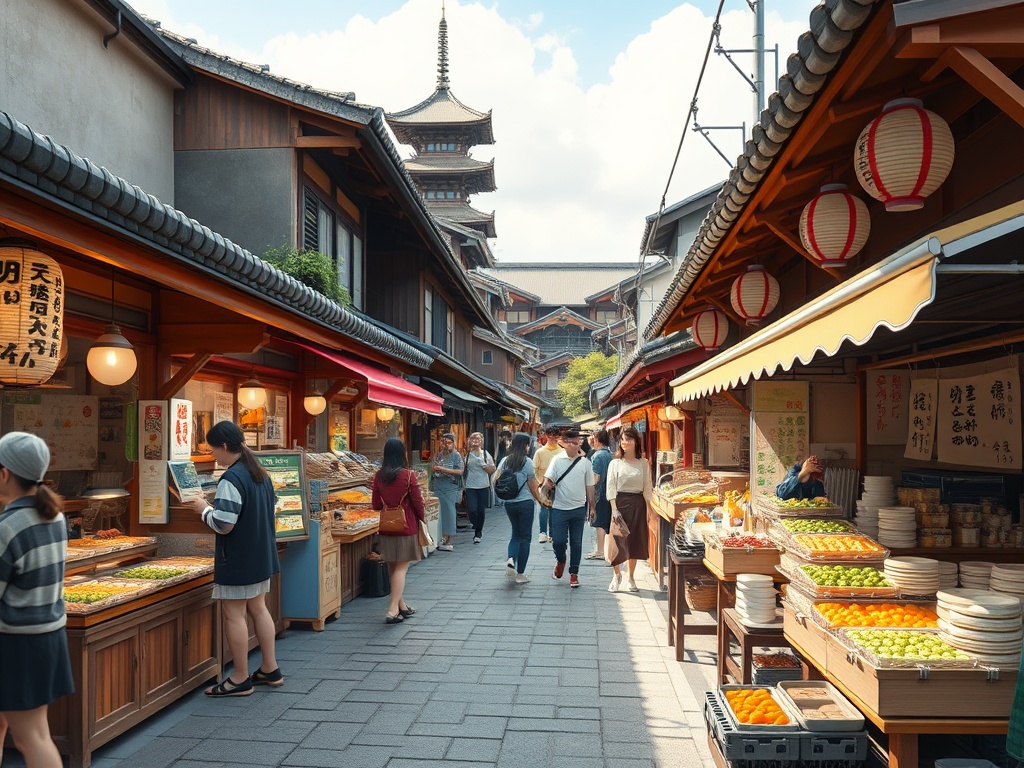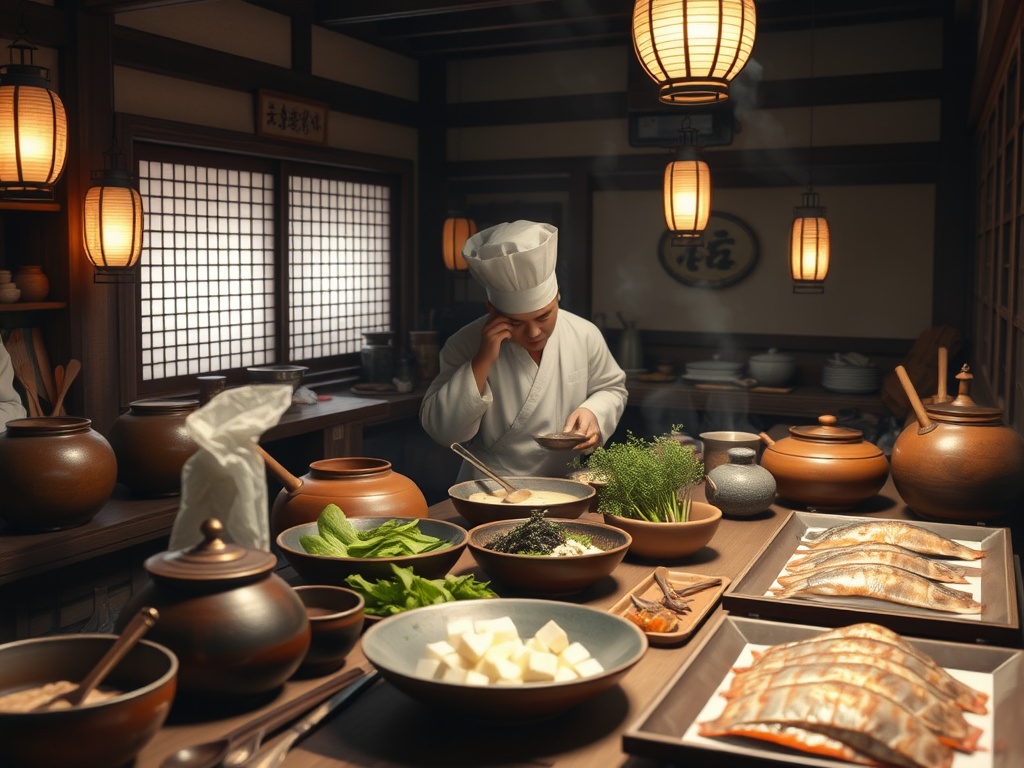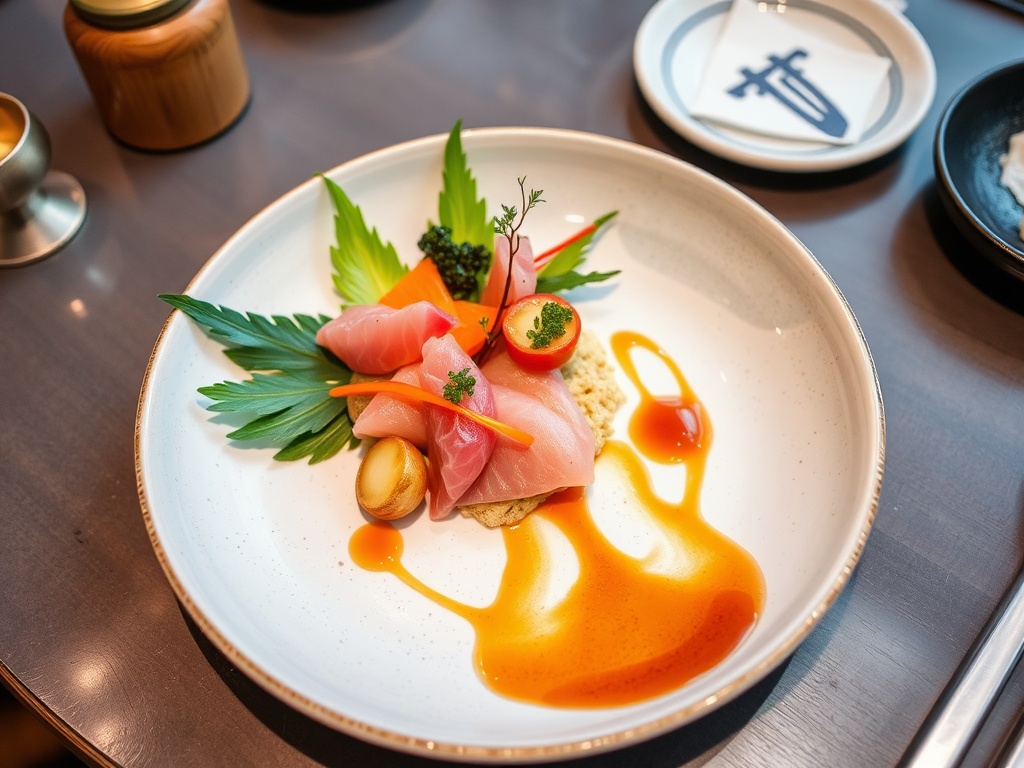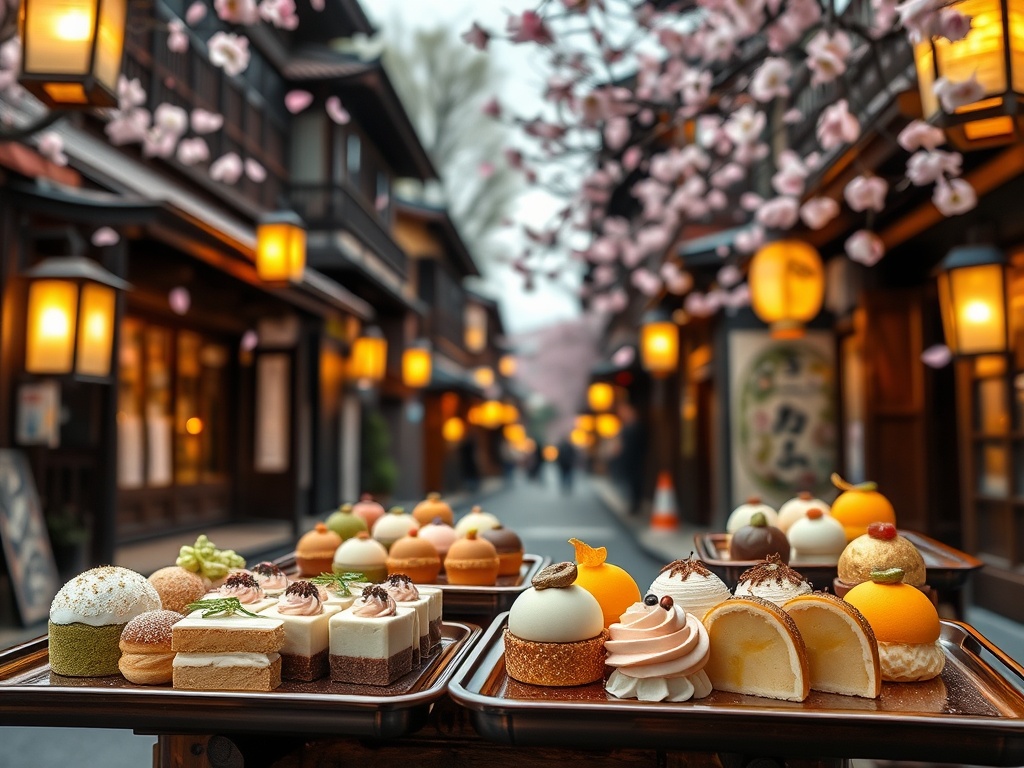Savor the Past: Timeless Dishes from Kyoto’s Ancient Kitchens
Win a Free Trip to Japan!
Experience cherry blossoms and ancient temples
Embark on a culinary journey through Kyoto’s ancient kitchens where the past comes alive on your plate. Known for its exquisite taste and attention to detail, Kyoto’s traditional cuisine offers a glimpse into Japan’s rich history. These dishes have been passed down through generations, maintaining their timeless allure while adapting subtle modern twists. Dive into the flavors that have shaped Kyoto’s culinary reputation, and experience a taste of the past like never before.
Explore the essence of Kyoto’s culinary identity through its signature historical dishes. These meals are not just food but a narrative of the city’s historical context and cultural richness.
- Yudofu: A simple yet elegant dish, Yudofu is a tofu hot pot that showcases the delicate flavors of Kyoto’s fresh tofu, often enjoyed at the serene temples.
- Kyo-kaiseki: This traditional multi-course meal is the epitome of Kyoto’s refined dining, offering a seasonal and visual feast that reflects the essence of Japanese aesthetics.
- Shojin Ryori: Originating from Buddhist temples, this vegetarian cuisine emphasizes harmony and simplicity, perfect for those seeking a spiritual connection through food.
While Kyoto’s ancient dishes hold their own charm, contemporary chefs are breathing new life into these classics by incorporating modern techniques and global flavors. Discover how traditional ingredients are being reimagined to excite the modern palate.
Matcha Innovations: Though rooted in tradition, matcha is being used in innovative ways, from savory dishes to creative desserts, offering a new perspective on this age-old ingredient.
Yuba Creations: Known as tofu skin, yuba is being transformed into a variety of textures and flavors, making it a versatile component in both traditional and modern dishes.
Fusion on a Plate: Where Tradition Meets Innovation in Kyoto Cuisine
Kyoto’s culinary scene is a mesmerizing blend of time-honored recipes and cutting-edge gastronomy, where the past and present coexist deliciously on every plate. As the ancient capital of Japan, Kyoto offers a rich tapestry of flavors that have evolved through centuries. Today, chefs are pushing boundaries, merging traditional techniques with international inspirations to create dishes that not only pay homage to their origins but also captivate the modern diner.
In Kyoto, chefs are reinterpreting traditional dishes with an innovative flair, creating a unique dining experience that excites the senses. This fusion approach respects the essence of the original recipes while embracing new culinary techniques.
Signature Fusion Dishes:
- Yuzu-Glazed Miso Salmon: A contemporary twist on the classic miso-marinated fish, this dish introduces a citrusy yuzu glaze that enhances the umami flavors, offering a vibrant palate experience.
- Matcha-Infused Ramen: Traditional ramen noodles are elevated with a subtle matcha broth, creating a harmonious blend of flavors that perfectly encapsulates the spirit of Kyoto’s culinary innovation.
- Sake-Infused Sushi: A creative take on sushi, where rice is delicately flavored with premium Kyoto sake, adding a unique depth to each bite.
Kyoto’s chefs are not only preserving their culinary heritage but also embracing international cooking methods to offer an exciting global palette. This cross-cultural fusion is evident in the city’s bustling food scene, where familiar ingredients are given a new life through a global lens.
From kimchi-infused okonomiyaki to tempura with a hint of Mediterranean herbs, these innovations reflect Kyoto’s openness to the world while maintaining its culinary authenticity. As a result, Kyoto has become a melting pot of flavors, inviting food enthusiasts to embark on a gastronomic adventure that honors the past and celebrates the future.
A Sweet Journey: Discovering Kyoto’s Irresistible Desserts
In the heart of Kyoto, the art of dessert-making is a delicate dance that marries ancient traditions with modern creativity. As you wander through the cobblestone streets and tranquil tea houses, you’ll discover a plethora of sweet treats that tell the story of Kyoto’s rich cultural heritage. From centuries-old confectioneries to contemporary innovations, Kyoto’s dessert offerings are a testament to the city’s ability to beautifully blend the old with the new.
The sweets of Kyoto, known as wagashi, are as much about aesthetics as they are about taste. These traditional desserts are often enjoyed with a cup of matcha during tea ceremonies, making them an integral part of Kyoto’s cultural fabric.
- Yatsuhashi: This iconic Kyoto snack is made from rice flour, sugar, and cinnamon, available in both baked and raw versions. The raw version, known as nama yatsuhashi, is often filled with sweet bean paste.
- Uji Matcha Parfait: A delightful creation featuring layers of matcha ice cream, mochi, and red bean paste, providing a refreshing escape during warm Kyoto afternoons.
- Sakura Mochi: Celebrated during cherry blossom season, these pink mochi sweets wrapped in pickled sakura leaves embody the fleeting beauty of spring.
While Kyoto cherishes its traditional sweets, a new wave of dessert artisans are infusing global influences and modern techniques, creating a dynamic dessert scene that appeals to both locals and visitors.
Matcha Tiramisu: This fusion dessert brings together the rich flavors of Italian tiramisu with the earthy notes of Kyoto’s premium matcha, resulting in an indulgent treat that delights the senses.
Yuzu Cheesecake: A zesty twist on the classic cheesecake, this dessert incorporates the aromatic yuzu citrus, delivering a refreshing and tangy experience.
For those eager to embark on a sweet journey, here are some of Kyoto’s top dessert spots that are sure to satisfy your cravings:
| Location | Specialty |
|---|---|
| Gion Tsujiri | Renowned for its matcha parfaits and green tea desserts. |
| Shimizu Ippoen | Famous for its traditional yatsuhashi and wagashi sweets. |
| Yojiya Café | Known for its matcha-infused desserts and signature tiramisu. |
Market Mysteries: Unveiling Local Ingredients at Kyoto’s Nishiki Market
In the heart of Kyoto lies a vibrant tapestry of colors, aromas, and flavors—Nishiki Market. Known as the ‘Kitchen of Kyoto’, this bustling marketplace is a treasure trove for culinary enthusiasts eager to explore the origins of the city’s renowned cuisine. As you meander through the narrow passages, each stall unveils secrets of Kyoto’s gastronomic history, offering a glimpse into the ingredients that have sustained its kitchens for centuries.
At Nishiki Market, the allure lies not just in the well-trodden paths but in the hidden gems that whisper stories of Kyoto’s culinary past. Obanzai, a traditional style of Kyoto home cooking, finds its essence in the local produce available here. From the delicate Kyoto vegetables like Kamo eggplant and Mibuna greens to the aromatic herbs that infuse dishes with subtlety, each ingredient is a piece of Kyoto’s cultural mosaic. Among the stalls, you might stumble upon rare finds such as fresh Yuba (tofu skin), cherished for its versatility and rich texture, or the exquisite Nama-fu, a gluten cake that adds a chewy texture to many traditional dishes.
The market is not just about the ingredients, but also about the artisans who dedicate their lives to preserving Kyoto’s culinary heritage. Engaging with these vendors offers a deeper understanding of how age-old methods are still in practice today. Watch a master craftsman meticulously prepare Tsukemono, the pickled vegetables that add a refreshing tang to meals, or learn about the intricate process of making Kyo-wagashi, the traditional sweets that exemplify Kyoto’s dedication to aesthetics and taste. These artisans are the keepers of tradition, breathing life into ingredients that have been the backbone of Kyoto’s kitchens for generations.
Tea Time Chronicles: The Art of Matcha in Kyoto’s Teahouses
In the serene embrace of Kyoto’s historic teahouses, time seems to stand still as the delicate art of matcha unfolds. This vibrant green tea powder is more than just a drink; it is a symbol of tranquility, tradition, and Kyoto’s enduring cultural legacy. As you step into a teahouse, the world outside fades away, and a ritualistic experience begins, where every sip of matcha connects you to centuries of Japanese heritage. Whether you’re a seasoned tea connoisseur or a curious traveler seeking new experiences, Kyoto’s teahouses offer an unforgettable journey into the heart of matcha.
The matcha ceremony, or chanoyu, is a refined practice that embodies the spirit of harmony and respect. Each movement is performed with grace, from the gentle whisking of the matcha to the ceremonial presentation of the tea bowl. Visitors are invited to partake in this age-old practice, learning the nuances of preparation and the profound meaning behind each gesture. It’s a meditative experience that offers a glimpse into the Zen philosophy deeply rooted in Kyoto’s culture.
Kyoto boasts a myriad of teahouses, each with its unique charm and approach to matcha. Here’s a curated list of must-visit teahouses that promise an authentic and enriching matcha experience:
- Uji Koubou: Nestled in the picturesque town of Uji, this teahouse is renowned for its premium quality matcha and offers a hands-on experience in grinding tea leaves.
- Camellia Tea Ceremony: Located in the heart of Kyoto, this intimate teahouse provides personalized tea ceremonies with English-speaking hosts, making it accessible to international guests.
- En Tea House: A modern twist on tradition, En Tea House combines contemporary design with classic tea rituals, providing a unique ambiance for tea lovers.
No matcha experience is complete without the perfect accompaniment of traditional Japanese sweets, or wagashi. These sweets are carefully crafted to balance the bitter notes of matcha with their subtle sweetness. Seasonal delights such as yokan, a jelly-like dessert, and dorayaki, fluffy pancakes filled with sweet bean paste, are often served alongside your tea, enhancing the overall sensory experience.
Zen and the Art of Kaiseki: A Multi-course Exploration of Kyoto’s Culinary Elegance
Kyoto’s culinary landscape is a testament to its rich cultural heritage, where each meal is a journey through time-honored traditions and meticulous craftsmanship. At the heart of this gastronomic heritage is Kaiseki, a multi-course dining experience that embodies the essence of Japan’s culinary philosophy. Known for its intricate presentation and exquisite flavors, Kaiseki is not merely a meal but a celebration of nature’s bounty, seasonal shifts, and the art of Japanese hospitality.
What sets Kaiseki apart is its profound connection to the seasons. Each course is thoughtfully crafted to highlight the freshest ingredients available, reflecting the changing landscapes of Kyoto. From the delicate sakura blossoms of spring to the vibrant maple leaves of autumn, Kaiseki captures the essence of Kyoto’s natural beauty on every plate. Chefs take inspiration from Zen philosophy, emphasizing simplicity and the harmony between food and nature. This seasonal approach not only enhances the flavors but also offers diners a sensory journey through Kyoto’s picturesque landscapes.
Experiencing Kaiseki is akin to participating in a well-choreographed dance, where each course unfolds with grace and precision. From the subtle flavors of a sashimi platter to the bold, umami-rich broths, every dish is a masterpiece that tells a story of its own. The artful presentation is as significant as the flavor, with dishes often resembling miniature landscapes that invite contemplation and appreciation. This attention to detail transforms the dining experience into a meditative practice, where diners are encouraged to savor each bite mindfully, embracing the tranquility that Kaiseki seeks to impart.
For those visiting Kyoto, indulging in a Kaiseki meal is an unforgettable experience that offers a deep dive into the city’s culinary soul. Whether in a traditional ryokan or a modern restaurant, this dining ritual offers a unique glimpse into the meticulous artistry that defines Kyoto’s food culture, making it an essential stop for any culinary enthusiast exploring Japan’s ancient capital.



